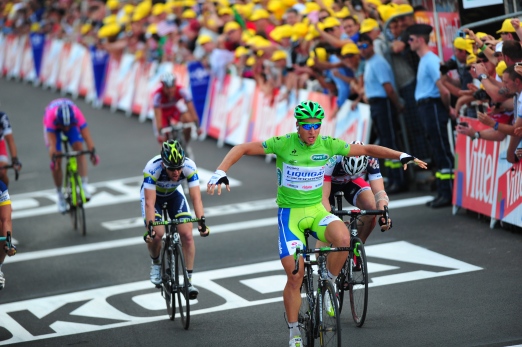In a series of posts aiming to explain the sport of cycling to new fans, different roles within cycling will be examined. First up, it’s the sprinters.
In the world of professional cycling, it is relatively easy to work out what role a certain cyclist may have by their appearance. Sprinters are usually bulkier than their fellow competitors, squat and with (as would be expected) larger leg muscles. Far better suited to flat stages, sprinters are capable of huge explosions of power in the final metres of a race, reaching up to 40 miles an hour.
Flat stages favour them because they are usually bad in hilly terrain and because flat stages are normally easier for a team to manage – break away groups form, but are less unpredictable. A typical flat stage will see a small group of riders breaking away from the main group (Peloton) and gaining a few minutes lead, before the Peloton slowly but surely turn the screws and catch the breakaway group within a few kilometres of the finish, leading to a frenetic but hugely entertaining ‘bunch sprint’. Sometimes a sprinter can win a sprint by a country mile, sometimes the colourful melee that ensues needs a photo finish, and sometimes it all goes badly wrong and collarbones break all over the place, but they are rarely boring.
There are nuances that exist from sprinter to sprinter – not everyone follows the same formula. Although there probably exists a consensus on what constitutes a stage for the sprinters, teams will try and identify stages for their sprinters to target. The hugely successful bright new sprinter Peter Sagan is quite good at climbing (for a sprinter), and so favours stages that end with a kick, an uphill section towards the finish. The job of the team when it comes to helping their sprinter to win is on paper a relatively simple one – keep their man in the mix right up until the final stages, before attempting to catapult him towards the finish.
With the absence of an actual catapult, the tool available to the teams is widely known as the ‘lead-out train’. The lead-out train sees some or all of the team riding in a single line, much like the team pursuit on the track, with the sprinter protected towards the back of the line. Each team member puts in a turn on the front, punching a hole in the air for the men behind him and bearing the full aerodynamic load, before peeling off and letting the next man take his place. As the distance to the finish lessens, so does the number of riders in the lead out train until, eventually, it is just the sprinter and his designated lead-out man left.
The teams who ride exclusively for their sprinters (with no desire to target the overall classification) usually pair their sprinter with his own lead-out man. The lead-out man is normally a seriously quick sprinter in his own right, and it is his job to get the sprinters legs spinning, delivering the final aerodynamic hole before peeling away and unleashing the beast behind him. The most successful pairing in recent years was certainly Mark Cavendish and Mark Renshaw who, at HTC Highroad, engineered virtual sprinting dominance.
It is important to note that in the sporting anomaly that is cycling, sprinters are never in contention for overall wins in grand tours such as the Tour de France. In the modern age it is incredibly rare to see a sprinter in the yellow jersey, and basically impossible for them to win it. Rather than racing for time, as those concerned with winning overall do, sprinters race for points and their own points jersey. In the Tour de France, the sprinters points jersey is green. Sprint finishes normally have the most significance, but there are some intermediary sprints for points that occur during stages as well.
Although some sprinters are better than others in the mountains, they are classically bad at climbing. When it comes to mountain stages therefore, it is imperative that they stay in touch with the rest of the field, or they risk disqualification due to missing the cut-off time for finishing the stage. This has happened to a number of prolific sprinters, Mark Cavendish amongst them. They are the fastest men on the flat, but other sprinters who are able to fight through the mountains win the points jersey in the end. It is important for their teams to make sure that this doesn’t happen by supporting their sprinters in the mountains in any way they can.
Towards the end of their careers, sprinters can become one day race specialists, targeting races that require long range solo efforts.
Great sprinters include Mark Cavendish himself, Mario Cipollini, Erik Zabel and Robbie McEwen.


I think Tom Boonen is also a great sprinter although better on the one day classics he has won numerous stages of grand tours and the Points Classification of the TdF in 2007 🙂
Hi Alex, I agree, Boonen is certainly one of the greats. Boonen, McEwen and Hushovd were the first three sprinters that captured me when I first started watching the TdF. I didn’t include him purely because of his One Day Classic specialism – a path many sprinters take towards the end of their careers. Certainly an oversight on my behalf. I’m glad you enjoyed the post!